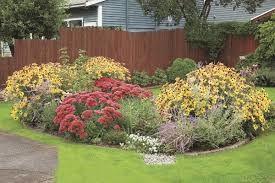Checklist for an Environmentally-Healthy Yard!

Checklist for an Environmentally-Healthy Yard!
1. Go Green with your Lawn
A super-green, lush carpet of grass can cause significant water quality problems. Because fertilizers and pesticides applied in excess are washed to rivers, streams, and wetlands, limiting their use can make a big difference. Even better, convert manicured lawn to natural meadow, beds of native perennials, and shrubs, or forest.
Kill Insects with Kindness
A list of non-chemical, natural insect repellants is here: eartheasy.com/live_natpest_control.htm
Fight Weeds with Eco-Friendly Herbicides
Try Deadeye (a vinegar-based formula) and WOW nitrogen fertilizer made from corn gluten. Pour boiling water or white vinegar on smaller weeds, like ones in walkway cracks.
Go Native
When landscaping, use native species (plants indigenous to Massachusetts) whenever possible. They require less water than grass, because they have deeper roots and can store more water. Growing native plants can save more than half the water normally used to care for outdoor plants. And, many of these species provide food and habitat for local wildlife. For more information, see greenscapes.org and grownativemass.org.
2. Don’t let those creatures go (info about exotic animals and invasive plants)
Although exotic animals can be great pets and ornamental plants can make beautiful decorations, many of these species are invasive. In fact, some of the characteristics that make these species desirable, like hardiness and rapid growth, are the same characteristics that allow them to out-compete native plants and animals in the wild. So never release aquarium pets or bait into the water. Also, use native plants and animals in water gardens.
3. Plant a Rain Garden
Locate your rain garden in a natural low spot where it can intercept runoff from hard surfaces such as streets, driveways and walkways. Keep it at least 15 feet away from building foundations. For more information, check out raingardennetwork.com.
4. Compost Yard Waste
A lot of people think that because grass clippings, brush, and other yard waste are ‘natural’, it is ok to dump huge piles in the woods or wetlands. However, dumped yard waste destroys the underlying vegetation and wildlife habitat, and prohibits new trees and shrubs from growing. Leaf dumping near water bodies has resulted in flooding problems upstream. Roadside ditches, used to remove road run off, can get clogged from leaves dumped by residents and landscapers. Lynnfield residents may bring their yard waste including grass, leaves, and brush to the DPW yard behind Town Hall during posted hours.
5. Scoop the Poop
Pet waste can be a significant contributor to local water quality problems. It contains parasites that can cause human and pet health problems and be harmful to our local wetlands and streams. Please pick up after your pet and dispose of pet waste in the trash. Never throw pet waste into a storm drain or waterway.
6. A Slow Drip Can do Big Damage
Oil, gasoline, and antifreeze from cars, trucks, lawnmowers, and boats are highly toxic to wildlife. If you notice a leak, fix it right away to keep these toxins from polluting our waterways.
7. Drain Swimming Pools Wisely
Never drain pool or hot tub water directly into a body of water. The best option is to discharge chlorinated water over landscaping using the following steps: (1) shut off the chlorination system or stop adding chlorine one week before draining pool water; (2) make sure the pH level is between 6.5 and 8.5, the normal pH range of surface and ground waters; and (3) Drain pool water where it will not flow directly into a street, gutter, someone else’s property or a wetland.
8. Dead Wood is Good Wood
Dead wood is an essential component of forests and wetlands. In addition to providing habitat for a myriad of organisms, dead wood is critical to the health of the forest. Good forest health revolves around decomposing wood and leaves. Whether a standing oak that is riddled with woodpecker holes or a fallen willow that has created a snag in a small brook, dead wood fosters forest life. Please reconsider “cleaning up” or “clearing out” forested areas of your property.
9. Wetlands are Wonderful
Wetlands are valuable because they reduce flooding, provide wildlife habitat, help recharge aquifers, and filter polluted water. Wetlands may not be wet all the time. Low areas that flood in the spring may be wetlands. All kinds of wetlands are protected by the Massachusetts Wetlands Protection Act. A surprising 39.9% of Lynnfield falls under wetland regulations, so your property may, too! Always contact your Conservation Commission before you consider working near wetlands and waterways (781) 334-9495.
10. Protect Wetlands with Planting a Natural Pollution Barrier Around Them
If you live on the banks of a pond or stream, or adjacent to a wetland, a vegetative buffer is particularly important to prevent runoff from going directly into these waters. Protecting water bodies with native vegetated buffer zones will help maintain water quality, recreational resources, wildlife habitat, and property value. Check out this Guide to creating a beautiful Backyard Buffer: https://highstead.net/pdfs/Riparian-Buffer-System.pdf
Prepared by the Lynnfield Conservation Commission with assistance from Weston Conservation Commission

